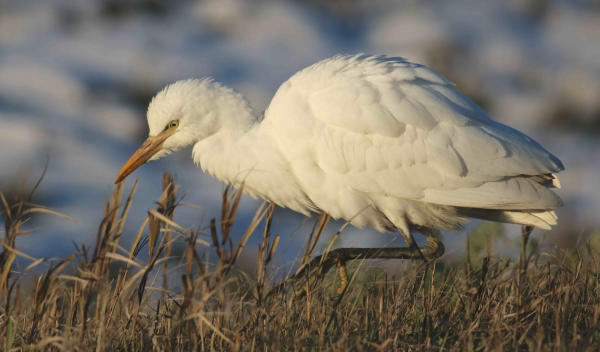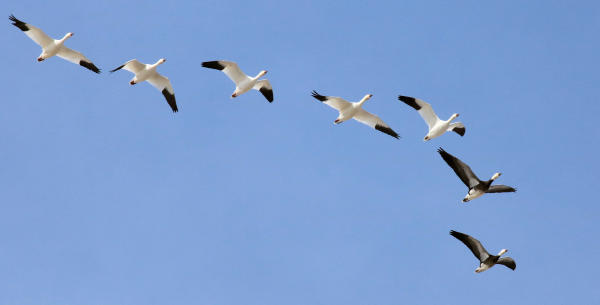
A “snow egret” turned out to be a Cattle Egret in the snow.

After the blizzard, the snow continued to fly, in the form of flocks of Snow Geese.
|
Peter started the discussion this week: I celebrated National Wildlife Refuge Week with hundreds of Gray Catbirds and other migrants at the Savannah National Wildlife Refuge in South Carolina. The main draw there is a five mile wildlife drive that features freshwater impoundments on the inside and tidal marshes and other habitats on the outside. Most people drive it, but I love to walk it.
The road passes through a half-dozen stands of forest that were teeming with migratory birds. Gray Catbirds were everywhere, feeding on berries. Best birds of the day for me were a Yellow-breasted Chat and a nice Merlin feeding on a dragonfly. White-eyed Vireos were abundant; there seemed to be one or two in every brush patch. Migratory warblers were a little scarce, with the Western version of Palm Warblers being most abundant. There was a nice movement of Indigo Buntings in particular – I tallied 11 Indigos, along with one nice bright-green juvenile male Painted Bunting.
Savannah Refuge is a waterbird haven. I saw one Purple Gallinule and a couple dozen Common Gallinules. I recorded the first Roseate Spoonbills I’ve seen at this refuge, and there were also Glossy and White Ibis, Wood Storks and a host of herons and egrets.
According to the stats on my eBird list, I tallied 56 species in 4 hours and 40 minutes of birding, and I walked 7.2 miles. How blessed are we to live in a country that protects such awesome habitats for birds and birders?
Paul countered: You know how I was excited to report finding a big female dark-morph Harlan’s Red-tailed Hawk during last Saturday’s October Big Day? Well, the next day I found another one during my Sunday outing. At first I thought it must be the same hawk as I found the day before, considering it too had a mostly white tail, but this Harlan’s had a light breast and a linear demarcation between its light-brownish breast and chocolate-brown body.
There were some other fine new Sunday sightings too. Just a mile south of home I spied a Krider’s Red-tail perched in a small grove of trees, but when I positioned myself for a better look with binoculars, I first saw a little falcon perched a couple trees to the north of the Krider’s. A Merlin? A closer inspection in poor light revealed it was a male Merlin. But back to the hawk, I must point out that to see a Krider’s, a Harlan’s, and immature and adult “normal” Red-tails within four miles of my house is pretty impressive. During the same drive, I found three Bald Eagles; two were perched seven miles south and one less than four miles south.
Monday was even rainier and drearier, but only a couple hundred yards south of my house I found yet another dark-morph Harlan’s Red-tailed Hawk perched on an open snag in the rain. This one, however, had an orange tail. Quite remarkable to see such an influx of Harlan’s – three in three days – and the Krider’s was still present a mile south; this time I photographed it and appreciated the unique banding on its pale-orange tail.
Tuesday, a mix of rain and snow made the day a virtual birding bust, and sunrise Wednesday morning revealed an all-out blizzard with several inches of wet snow accumulated and no sign of a let-up of the snow or 35mph wind.
Thursday revealed a break in the bad weather and a look at the sun for the first time in two weeks. As I returned home from Bismarck, I thought, “What did the storm blow in on those north winds?” I was not disappointed. I enjoyed seeing and hearing my first assemblage of about 100 Sandhill Cranes during my (celebratory) visit to Long Lake National Wildlife Refuge. I watched the cranes a while as small flocks of Sandhills took flight to reposition for feeding in a field to the north. It was fun to watch their take-offs, flights and circling landings; and I reveled in the sounds of their wild calls as I checked out and photographed many other wading birds, waterbirds and ducks.
As I continued driving home, I was surprised to see a small white egret standing in the snow near the road – ah, a snow egret I thought with a little chuckle. But was it really a more common Snowy Egret, or a Cattle Egret? When I reversed to the location I saw the snow bird was a Cattle Egret, and there were two of them. I approached the trusting birds to photographing them in the snow as they hunted among wet grasses. There were no cattle around, so really, they must be snow egrets (ha-ha).
A little farther down the highway I sighted much-anticipated “harbingers of late fall,” a flock of about 100 Snow Geese, followed by about 35 Snows a few miles down the road, and another flock of about 120 Snow Geese several miles farther. Each flock had a mix of white and blue morph Snows and I was able to savor the first wild calls of the flying geese – I enjoy these Arctic-nesting geese so much.
Friday, just a mile north of my house, I found five Trumpeter Swans – so rare in this area. When I checked back on this location Saturday, the swans were absent, but it was fulfilling to find a small flock of about 35 Snow Geese feeding on the edge of a marsh, close to the road. There were about equal numbers of blue- and white-morph Snows in the little flock that obviously included some family groups with young of the year feeding in the company of two adults. There were even a couple hybrid color morphs that resembled a blue goose with a white belly, and one that was mostly white with blue-gray back and wing feathers. The flock was a microcosm of the tens of thousands of Snow Geese that will follow, growing to hundreds of thousands in a couple weeks – it’s the beginning of an exciting period in my neighborhood!
South of home, I found yet another dark-morph Harlan’s Red-tailed Hawk (with an orange tail) moving quickly in circular migration flights southward, a second-year Bald Eagle that flushed about 80 Mallards as it coursed the area, and the biggest Snow Goose flock yet, numbering about 160 of the Arctic migrants. Whadda week!
Photographs by Paul Konrad
Peter Stangel and Paul Konrad are the editors of The Birding Wire; share your sightings or photos at editorstbw2@gmail.com